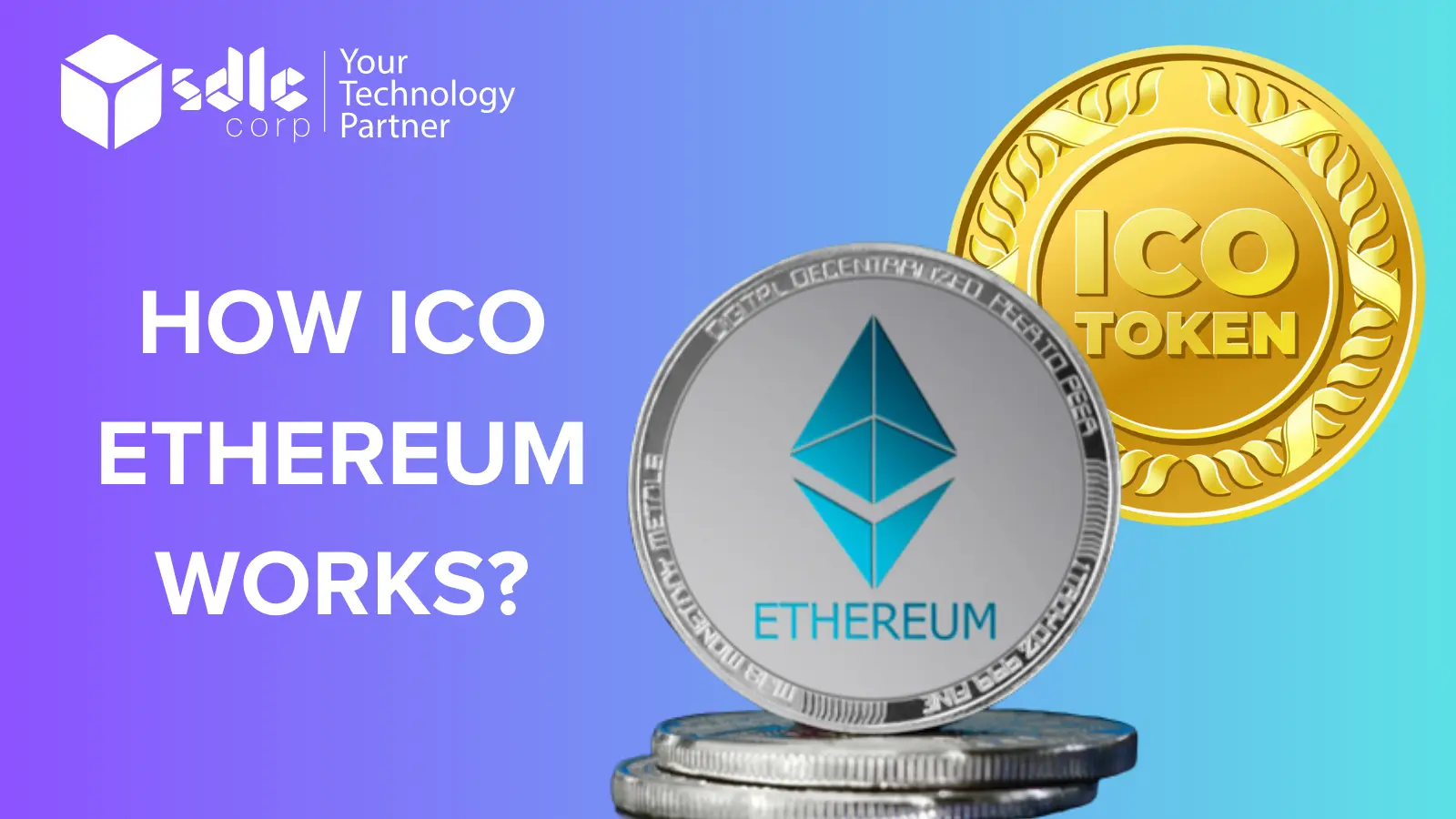How ico ethereum works?
Initial Coin Offering (ICO) on the Ethereum blockchain involves creating and distributing a new cryptocurrency token to investors in exchange for funds. Ethereum, a decentralized platform that enables smart contract functionality, has become a popular choice for ICOs due to its robust infrastructure and widespread adoption within the blockchain community. Launching an ICO is to develop a solid idea for your project. This could involve identifying a problem in a specific industry or creating a new decentralized application (DApp) with unique features and functionalities. The core of your ICO will be a smart contract deployed on the Ethereum blockchain. This smart contract defines the behavior of your token, including its supply, distribution, and functionality. You must write the smart contract code using Solidity, Ethereum’s native programming language, or another compatible language. Build anticipation for your ICO by engaging with the community through social media, forums, conferences, and other channels. Develop a marketing strategy to raise awareness of your project and attract potential investors. ICO, allocate resources to fulfill your project’s roadmap and deliver on your promises to investors.

While not strictly required, establishing a foundation for an ICO offers several benefits. It helps ensure legal compliance by navigating regulatory frameworks, enhances credibility and trust among investors, and provides transparent governance structures. A foundation also facilitates investor protection mechanisms and contributes to the project’s long-term sustainability by establishing a framework for ongoing operations and community engagement. Overall, while optional, forming a foundation for an ICO is often advisable to navigate legal complexities, build trust, and ensure the project’s success.
Features
1. Smart Contract Functionality:
Ethereum’s smart contract capabilities allow for the creation of programmable tokens, enabling customizable token functionality, such as automatic distribution, token burning, and more.Decentralized Nature: Ethereum operates on a decentralized network of nodes, ensuring transparency, immutability, and censorship resistance for ICO transactions and token distribution.
2. Interoperability:
Ethereum-based tokens are interoperable with other Ethereum-based applications and tokens, fostering a robust ecosystem and facilitating integration with decentralized exchanges (DEXs) and other platforms.
3. Token Standardization:
Ethereum’s ERC (Ethereum Request for Comment) standards, such as ERC-20, ERC-721, and ERC-1155, provide guidelines for token creation, ensuring compatibility with wallets, exchanges, and other Ethereum-based services.
4. Security and Auditability:
Ethereum’s established ecosystem, community support, and auditing tools facilitate the development of secure smart contracts and provide mechanisms for auditing code to identify and mitigate potential vulnerabilities.
5. Global Accessibility:
Ethereum’s global reach and accessibility enable ICOs to attract investors from around the world, fostering a diverse and inclusive investment community.
Eager to understand ICO Ethereum? Let's explore together!

Idea Generation and Conceptualization
This stage is all about identifying a problem or opportunity that can be addressed or leveraged using blockchain technology on the Ethereum platform. It involves brainstorming and research to come up with innovative ideas that have the potential to solve real-world problems, disrupt industries, or provide valuable services. Key steps in this process include:
1. Research:
Conduct thorough market research to identify trends, pain points, and areas for potential disruption. Explore existing blockchain projects to understand what has already been done and where gaps or opportunities exist.
2. Problem Identification:
Identify a specific problem or inefficiency within an industry or community that could benefit from blockchain technology. Consider issues such as transparency, trust, security, and efficiency.
3. Solution Proposal:
Once a problem has been identified, propose a solution leveraging blockchain technology. Think about how decentralized networks, smart contracts, and tokenization could be used to address the problem effectively.
4. Value Proposition:
Clearly articulate the value proposition of the proposed solution. What unique benefits does it offer compared to existing solutions? How will it improve the lives or operations of stakeholders?
5. Feasibility Assessment:
Assess the technical feasibility of implementing the proposed solution on the Ethereum blockchain. Consider factors such as scalability, interoperability, and potential challenges in development and deployment.
Smart Contract Creation
Smart contracts are self-executing contracts with the terms of the agreement directly written into code. In the context of an ICO on Ethereum, smart contracts play a central role in managing token sales, distributing tokens to investors, and enforcing the rules of the ICO. Here’s a step-by-step guide to creating smart contracts for an Ethereum ICO:
1. Choose a Development Environment:
2. Define Token Contract:
3. Implement ICO Logic:
4. Set Pricing and Parameters:
5. Handle Funds Securely:
Smart Contract Creation

Finalize Legal and Regulatory Compliance:
- Ensure that your ICO complies with relevant securities laws, anti-money laundering (AML) regulations, and know-your-customer (KYC) requirements.
- Consult legal experts to review your ICO structure, tokenomics, and marketing materials for compliance.
- Implement necessary KYC/AML procedures to verify the identity of contributors and prevent participation from restricted jurisdictions.
Secure Partnerships and Service Providers:
- Partner with cryptocurrency exchanges to facilitate token listing and liquidity post-ICO.
- Engage with payment processors and wallet providers to handle contributions securely.
- Collaborate with auditing firms for smart contract audits and security assessments.
- Secure partnerships with marketing agencies, PR firms, and influencers to promote your ICO.
Develop ICO Website and Marketing Materials:
- Create a professional website with detailed information about your project, team, whitepaper, token sale details, and roadmap.
- Develop compelling marketing materials, including press releases, blog posts, social media content, and email newsletters.
- Design engaging graphics, videos, and presentations to showcase your project and attract potential investors.
Set ICO Parameters:
- Determine the start date, duration, and token sale structure for your ICO.
- Define the token price, token allocation, funding goals, and any bonus or discount structures.
- Establish contribution limits, minimum and maximum investment amounts, and accepted payment methods (e.g., ETH, BTC, fiat).
Conduct Pre-Launch Marketing and Community Engagement:
- Build anticipation for your ICO through targeted marketing campaigns and community engagement efforts.
- Utilize social media platforms, forums, and online communities to generate buzz and attract potential investors.

Determining the suitability of investing in the LocalCoinSwap ICO depends on various factors including market conditions, project fundamentals, and individual risk tolerance. Conduct thorough research on the project’s whitepaper, team expertise, and roadmap to assess its potential for success. Consider factors such as market demand for decentralized exchanges, competition, and regulatory risks. Additionally, evaluate the ICO’s tokenomics and distribution model. Consulting with financial advisors and staying informed about industry trends can aid in making an informed investment decision.
Conducting the ICO
Once all the preparations have been made, and the ICO launch is imminent, it’s time to conduct the actual token sale event. Here are the steps involved in conducting the ICO:
Open the Token Sale:
- At the designated start time, open the token sale to participants. Ensure that the ICO website and platform are live and accessible for contributions.
Accept Contributions:
- Accept contributions from investors in exchange for tokens. Provide clear instructions on how investors can participate, including wallet addresses for sending contributions and any required KYC/AML procedures.
Monitor Contributions:
- Monitor incoming contributions to ensure that they are processed correctly and accurately. Implement mechanisms to track contributions and update token balances accordingly.
Provide Support:
- Offer customer support and assistance to investors throughout the ICO process. Address any questions, concerns, or technical issues promptly and professionally.
Communicate Updates:
- Provide regular updates and progress reports to investors and the community. Keep participants informed about the status of the ICO, fundraising milestones, and any important announcements.
Ensure Transparency:
- Maintain transparency in the ICO process by providing visibility into token sale metrics, such as total funds raised, token distribution, and remaining tokens available for sale.
Explore the mechanics of ICOs on Ethereum - let's get started!

Ensuring Security and Transparency
Security and transparency are paramount in conducting an ICO to build trust with investors and the wider community. Here’s how you can ensure both:
1. Secure Smart Contracts:
Conduct thorough testing and auditing of smart contracts to identify and address vulnerabilities. Implement best practices for secure coding and follow established standards like ERC-20. Consider using tools like automated security scanners and third-party audits to enhance security.
2. Secure Payment Channels:
Implement secure payment channels to protect investor funds during the contribution process. Use encrypted communication protocols, multi-signature wallets, and secure payment gateways to safeguard transactions.
3. Transparent Token Distribution:
Maintain transparency in token distribution by providing real-time updates on the allocation and distribution of tokens. Publish information on token sale metrics, such as total funds raised, tokens sold, and remaining tokens available for sale.
4. Publicly Verifiable Transactions:
Leverage the transparency of the Ethereum blockchain to enable investors to verify transactions independently. Provide access to transaction hashes and contract addresses for investors to validate their contributions and token allocations.
5. Regulatory Compliance:
Ensure compliance with relevant legal and regulatory requirements to mitigate legal risks and protect investors. Implement KYC/AML procedures, adhere to securities regulations, and comply with tax laws applicable to token sales in your jurisdiction.
6. Open Communication Channels:
Maintain open communication channels with investors and the community throughout the ICO process. Provide regular updates, address questions and concerns promptly, and foster a culture of transparency and accountability.
Experience the future of work today by getting started with ICO

Benefits
ICO (Initial Coin Offering) on Ethereum offers several benefits, both for project founders and investors. Here are some of the key benefits:

Access to Capital:
ICOs provide a mechanism for blockchain projects to raise capital by selling tokens to investors. Ethereum’s ICO platform allows projects to access a global pool of investors, bypassing traditional fundraising methods like venture capital.
Decentralization:
Ethereum is a decentralized platform, meaning that ICOs conducted on Ethereum benefit from the platform’s decentralized nature. This decentralization ensures transparency, immutability, and censorship resistance, aligning with the ethos of blockchain technology.
Smart Contract Functionality:
Ethereum’s smart contract capabilities enable the creation of programmable tokens, allowing ICO projects to define custom token functionalities, distribution mechanisms, and governance rules. Smart contracts automate token sales, ensuring transparent and secure transactions.
Interoperability:
Ethereum-based tokens are interoperable with other Ethereum-based applications and tokens, fostering a vibrant ecosystem of decentralized finance (DeFi) projects, decentralized applications (DApps), and tokenized assets. This interoperability enhances liquidity and utility for ICO tokens.
Global Accessibility:
Ethereum’s global reach and accessibility enable ICO projects to attract investors from around the world, democratizing access to investment opportunities. Anyone with an internet connection and an Ethereum wallet can participate in ICOs, promoting inclusivity and financial inclusion.
Community Engagement:
Ethereum has a large and active community of developers, investors, and enthusiasts. Conducting an ICO on Ethereum allows projects to tap into this community, garnering support, feedback, and collaboration from stakeholders.
"Maximize fundraising opportunities for your project with SDLC Corp’s ICO development company"

Conclusion
Ethereum blockchain is a complex yet rewarding endeavor that offers numerous benefits for blockchain projects and investors alike. Throughout this guide, we’ve outlined the key steps involved in conducting an ICO on Ethereum, from idea generation and smart contract creation to marketing, conducting the ICO, and ensuring security and transparency. Ethereum’s smart contract functionality, decentralization, and interoperability, ICO projects can access a global pool of investors, raise capital, and innovate in the rapidly evolving blockchain space. Ethereum’s vibrant ecosystem, active community, and decentralized infrastructure provide a conducive environment for launching successful ICOs and driving the adoption of blockchain technology.an ICO on Ethereum comes with regulatory, technical, and operational challenges. Legal compliance, security best practices, transparent communication, and investor protection should be top priorities for ICO projects to build trust, credibility, and long-term sustainability. Ethereum-based ICOs have the potential to catalyze transformative change and drive the next wave of innovation in the blockchain industry.















